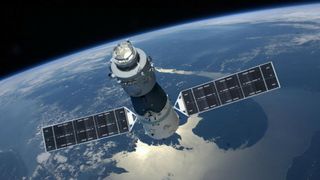SpaceX’s 'Starlink' proposal will launch 12,000 satellites for total worldwide broadband coverage
Total worldwide broadband coverage with minimal latency

SpaceX cleared a major hurdle in its goal to launch a network of broadband satellites in low Earth orbit yesterday, when the FCC approved a revised draft of their 2016 proposal.
Today's news follows the story from last month where Elon Musk’s company, SpaceX, launched its first two satellites into orbit during their PAZ mission from Spain.
Nicknamed Tintin A and B, they temporarily blasted a Wi-Fi-enabled message to the city of Los Angeles.
Don’t tell anyone, but the wifi password is “martians”February 22, 2018
Now SpaceX can officially plan to launch thousands more satellites from the US, but they’d better book their launchpad schedule well in advance: the FCC requires that they launch half of their 4,425-satellite fleet by 2024—a six-year deadline.
Current broadband satellites sit tens of thousands of kilometers above the surface; Starlink would place their 4,425 satellites at only 700 miles (1,150 kilometers), then launch another 7500 satellites at only 200 miles (320 kilometers), according to SpaceX’s FCC filing.
Broadband for the masses
So close to Earth’s surface, Starlink satellites would have minimal latency delays, supposedly comparable to current cable and fiber response times. SpaceX VP Patricia Cooper told the US Senate Chamber of Commerce that the network would provide 25ms latency and 1 Gbps speeds.
FCC chairman Ajit Pai led the unanimous vote approving SpaceX’s proposal. In a statement, Pai said, “Satellite technology can help reach Americans who live in rural or hard-to-serve places where fiber optic cables and cell towers do not reach. And it can offer more competition where terrestrial Internet access is already available.”
Get daily insight, inspiration and deals in your inbox
Get the hottest deals available in your inbox plus news, reviews, opinion, analysis and more from the TechRadar team.
The FCC has reserved the right to revoke their license, if SpaceX can’t also obtain permission from the International Telecommunication Union, which controls the radio bandwidths Starlink will use to send signals to the surface. But beyond that, they can proceed full steam ahead.
SpaceX isn’t the only company hoping to fill up our skies with satellites. OneWeb received FCC permission last year to launch 720 satellites using Amazon’s Blue Origin rockets, and an Apple-Boeing partnership could yield up to 3,000 satellites.
Satellites vs 5G
Satellite broadband will let people around the world have access to fast internet speeds, which in the past would have required labor-heavy installation of fiber-optic networks stretching to every home—something especially difficult in rural areas.
In the decade or more it will take to fully roll out their network, SpaceX may be hoping that an Earth-based alternative to cables doesn’t take too much of their future business.
5G, the next-gen upgrade to our current model, provides 1 Gbps speeds without needing to connect each home to a fiber optic network. Instead, carriers can install fiber optic hubs every few blocks that communicate at incredible speeds with wireless modems. And these hubs apparently have the capacity for all the streaming and downloads that you might need.

Samsung and Verizon have already begun testing 5G in several cities across the US, and industry experts predict 5G will be the dominant mobile net source by 2025—right around the time Starlink could go online.
Of course, Starlink will also go to regions where no cable companies would ever install any fiber optics, 5G or otherwise. But to pay for all of these rocket launches, SpaceX will need to make a lot of money on its network; so no doubt he’ll also want plenty of first-world consumers to buy into his product as well.
Space just got crowded
To launch 2,200 satellites within six years, SpaceX will have to boost slightly more than one satellite per day. That will take monumental resources and planning to achieve on time without the satellites crashing into one another. And competitors like OneWeb will be trying to hit their own targets at the same time.
After SpaceX proposed its plan, OneWeb petitioned that the FCC reject it, claiming that the volume would inevitably lead to Starlink satellites or delivery rockets crashing into one another, or into OneWeb objects.
While OneWeb obviously had plenty of motivation for their rival’s proposal to fail, even NASA warned that current safety standards for satellites would no longer apply safely to Starlink, due to the sheer number of satellites it would require.

FCC Commissioner Jessica Rosenworcel, who voted for the proposal, warned of the dangers this could pose, should this rapid schedule risk satellites crashing into one another.
“As more satellites of smaller size that are harder to track are launched, the frequency of these accidents is bound to increase,” she said in a statement. “Unchecked, growing debris in orbit could make some regions of space unusable for decades to come.”
In response, SpaceX promised to coordinate with NASA, OneWeb, and any other satellite company planning on sharing low-orbit space with Starlink.
- We've got the latest on the FCC's dismantling of net neutrality and SpaceX's latest Falcon Heavy launch.
Michael Hicks began his freelance writing career with TechRadar in 2016, covering emerging tech like VR and self-driving cars. Nowadays, he works as a staff editor for Android Central, but still writes occasional TR reviews, how-tos and explainers on phones, tablets, smart home devices, and other tech.

